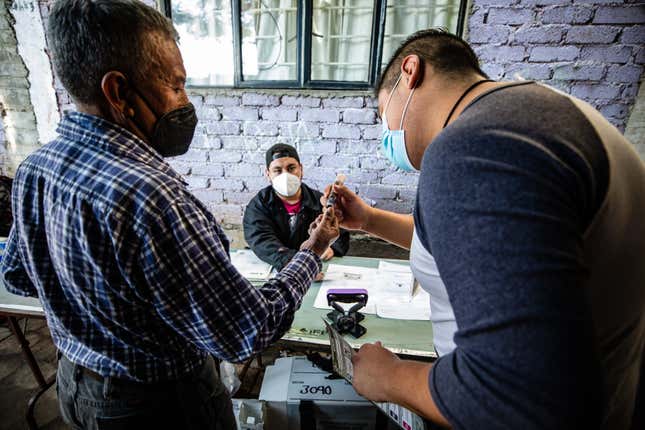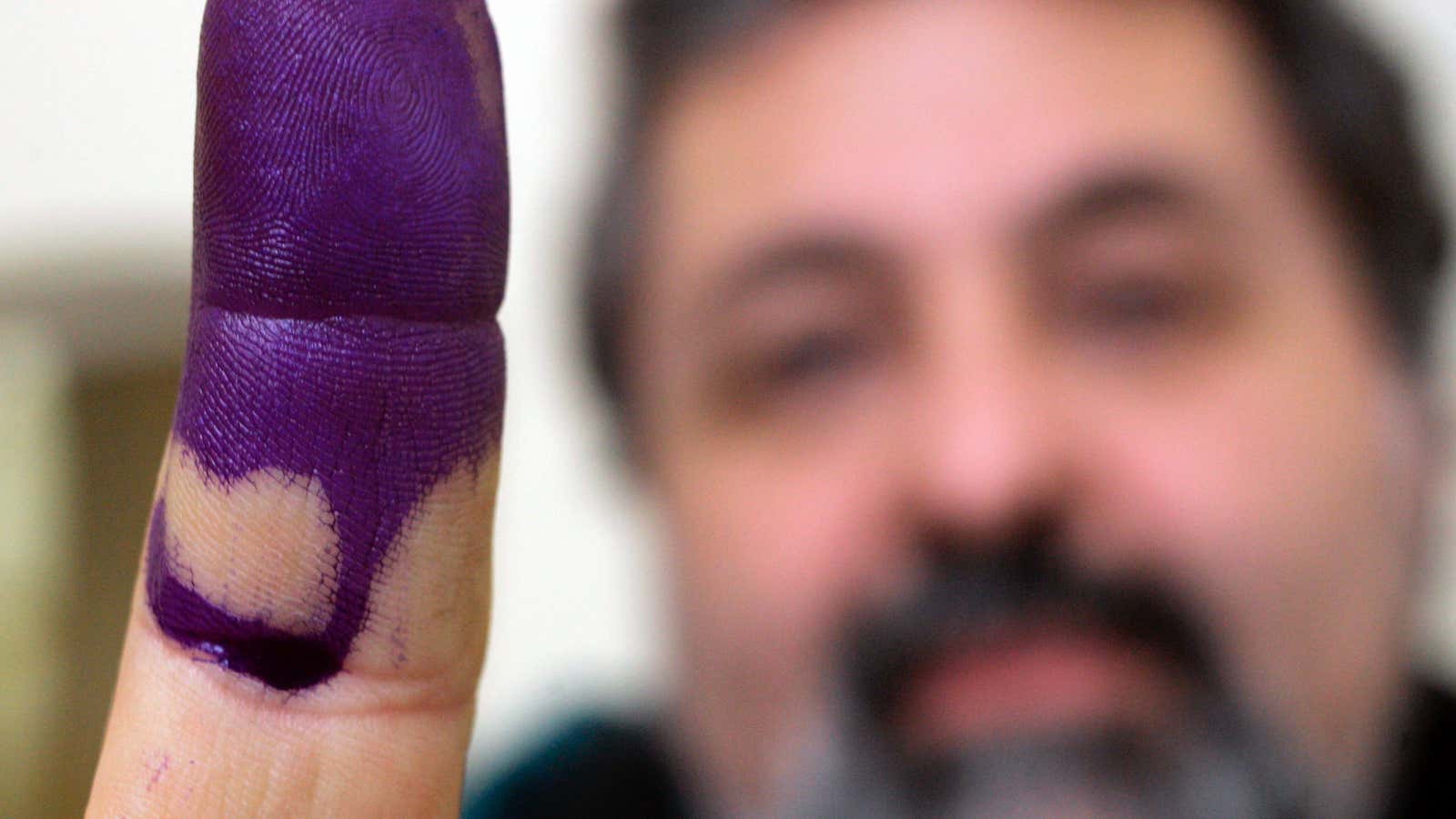A dye to test time
You’ve probably seen the pictures on social media: smiling folks holding up one finger at the camera, usually an index finger marked with a dark purple ink.
For about 90 countries, including India and the Philippines, these images are the equivalent of an American’s ‘gram of their “I voted” sticker. The splotch of ink on a finger indicates pride in democratic duty (well, maybe less democratic these days).
The ink of course has a practical use, too, deterring fraudulent voting. It’s pretty hard to get back in line to vote again if your finger is marked with semi-permanent dye. But that doesn’t mean it’s a faultless mechanism. A quick search of “how to get voting ink off of skin” suggests household items like lemons, salt, and paint thinners.
As with electronic voting systems in the US and, more recently, Brazil, doubt can be sown just about anywhere by those who benefit from a lack of faith in the system. A physical marking isn’t skeptic-proof, even if scientists say it can stand the test of time.
Let’s dip into it.
By the digits
90: Countries that have used indelible ink in elections
30: Countries to which indelible ink manufacturer Mysore Paints exports. Mysore is state-owned, and is the only company authorized to make indelible ink in India, using a secret formula.
86: Years Mysore has been in business
₹330 million ($4 million): Revenue Mysore took in from India’s 2019 elections
2.6 million: Bottles of indelible ink ordered ahead of India’s last parliamentary election in 2019
900 million: Indians that voted in that election
1 month: Duration the ink can stick around on someone’s nail
Explain it to me like I’m 5!
Indelible ink, or election ink, has been used since the 1960s to signify which people have already voted in an election. It’s especially useful in governments where voter identification isn’t standardized, and is sometimes used in tandem with documents as an extra safeguard.
When a person goes to a poll site, an election official applies the ink to their finger, often with a sponge, a brush applicator, or a pen. The ink usually begins as violet, but can turn brown and black once it interacts with skin. It’s typically applied to a voter’s left forefinger in a dash extending all the way to the cuticle, where it’s more difficult to remove the ink.
Pop quiz

Which chemical makes indelible ink indelible?
A. Talcum powder
B. Gold
C. Paraffin wax
D. Silver nitrate
Find the answer at the bottom.
Brief history
508 BCE: Ancient Greeks create the first democratic voting system.
13th century: German friar and bishop Albertus Magnus discovers silver nitrate.
1927: Liberia’s incumbent president Charles D.B. King wins his country’s election by a vote of 234,000 to 9,000—despite there being only 15,000 eligible voters. It’s largely seen as the most fraudulent election in history.
1937: Indian prince Krishnaraja Wadiyar IV, who at the time of his death was one of the world’s richest people, starts Mysore Paints.
1962: India’s election commission signs an agreement with Mysore Paints to make the company its indelible ink supplier.
2004: Vote counting in Afghanistan’s election stops after claims circulate that ink used to mark voters could be rubbed off.
Inked controversies

In 2013, Malaysia’s governing Barisan Nasional coalition gave in to public pressure calling for a fair general election and decided to use indelible ink to mark those who voted. But that act sparked backlash after people began saying the ink could easily be washed off.
Malaysia’s opposition party latched onto this, claiming the 2013 results were “marred with unprecedented election fraud,” though the country’s election commission insisted otherwise. Afghanistan saw a similar controversy in 2004, and again in 2009, when a Guardian journalist said he was able to get the ink off his finger after a few minutes.
Questioning the integrity of voting systems, and thus sowing doubt about the entire system, has long been a tactic by those seeking power. But some have gone even further and used what’s supposed to be a voting safety mechanism to induce fear.
In the 2008 Zimbabwe general election, militia groups loyal to president Robert Mugabe reportedly went door-to-door forcing people to vote and checking their fingers for ink. “People will not feel safe moving about with an unmarked finger,” one Zimbabwe citizen told the BBC. Reports of the intimidation led the EU to call the election a “sham.”
The covid pandemic presented a whole new kind of danger for voters. In addition to concerns about transmitting a dangerous illness among indelible ink users, the International Foundation for Electoral Systems was worried about increased disinformation (i.e. excessive hand-washing could remove indelible ink), and encouraged election management bodies to “actively work to counter messaging—particularly online—that is not factual.”
Quotable
“It will be a black mark on the commission and undermine the public confidence in the results. …The whole integrity of the electoral process has come into question.”
—Lim Kit Siang, a veteran opposition politician in Malaysia, questioning the integrity of the country’s elections in 2013 after reports spread that the ink could easily be washed away
Watch this 💅

A simple mixture of paint thinner, salt, and lemon juice—and a lot of scrubbing—can make indelible ink pretty delible, according to this tutorial. Just putting this here: We don’t condone election fraud.
Fun fact!
Back in the mid-1800s, when the Tammany Hall held New York City politics in an omnipresent grip, voters were encouraged to go to the polls multiple times and shave their beards before a second entry to throw off anyone who was tracking identities.
Poll
Is ink stronger than the sword?
- Give me that feather quill
- I prefer erasable pens
- I only write in the sand
Do your civic-ish duty and let us know!
💬 Let’s talk!
In last week’s poll about philanthropy, 72% of you said you’d pull a Keanu Reeves and give your wealth away. Nice!
🤔 What did you think of today’s email?
💡 What should we obsess over next?
Today’s email was written by Morgan Haefner (wants a delible pen to write secret letters) and edited by Susan Howson (prefers fountain pens).
The correct answer to the pop quiz is D., silver nitrate. Indelible ink usually has a concentration of 10%-18% silver nitrate and is safe to apply on the skin, but burns have been reported among polling officials who inadvertently get a lot of the stuff on their own fingers.
